Text
MAILBAG #1
I’ve gotten a great deal of comments and responses, and while I don’t want to appear to be a conversational blog, I do want to ensure that your important questions are getting answered. Thus, I’ll take this time to respond to relevant and thought-provoking questions.
@bidoofvselite-four said in response to Charizard “ Mewtwo also has 2 mega evolutions.” While this is a common rumor, it’s just that. Much of Mewtwo remains shrouded in mystery, and while there are various claims of two forms, the only reliable Mewtwo sightings have been at dimensional crossroads. While an alternate-dimension Mewtwo was confirmed to Mega Evolve, there’s still no hard proof that there even is a Mewtwo native to this dimension, or what it can or cannot do. The scientific community takes all comments on Mewtwo with a grain of salt and will continue to do so until it is produced.
@pepperonimoon says “Sableyes would be genderless if traditional reproduction would be impossible. Females and males exist for a reason!” This is a common comment, but it’s one that bears addressing. First, if Sableye are the spirits of the dead, as many believe, then their gender identity is simply a holdover from when they were human or other gendered species. Their life cycle would include reproduction before becoming Sableye, and, like Nidoqueen or older human women, would simply be past their ability to reproduce. If they are their own species, it becomes more likely they can reproduce in a traditional sense, but gender identity as determined by attraction for others and actual sex are not always 1-to-1. It’s entirely possible, albeit unlikely, that such gender roles evolved for a different reason. Ultimately, the simple answer is that we don’t know. It’s also possible that, like Togetic, Sabeleye reproduce entirely by the supernatural PokéEgg phenomenon.
@williamkillingly questioned the supernatural relationship between Santalune Forest in Kalos and Viridian Forest in Kanto, so please allow me to explain. Viridian Forest is a forest in Kanto populated by Pokémon and plants that are found throughout Kanto, as well as in Johto. Santalune Forest is a forest in Kalos populated by Pokémon and plants that are also found throughout Kanto, but not in the rest of Kalos, in addition to some more traditional Kalosian Pokémon. Not only that, but while wild Butterfree and Beedrill can be found throughout Kanto and Johto, they’re exceedingly rare in Kalos. Further, natural paths in the two forests seem to conform to the same shape to a suspicious degree. This is all despite the fact that they’re approximately 10,000km away from each other. Though nobody has done a proper study of Santalune, the general consensus is that something is very wrong with that forest.
I’ve also gotten MANY responses on the discussion of the species name of adult Nidoran, and I appreciate them all. Please keep commenting and feel free to send me any questions you have about any Pokemon, whether I’ve covered them or not, either for a future mailbag or to point me to what entries I should be doing next.
10 notes
·
View notes
Text
PIDGEOT
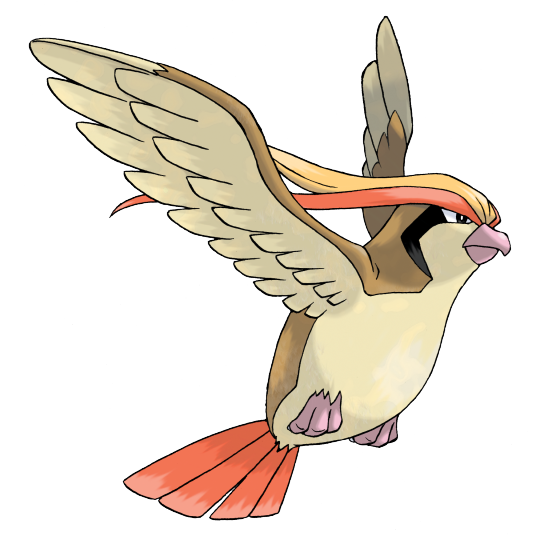
Pidgeot is a Flying- and Normal- type bird Pokémon with a long history of semi-domestication. Pidgeot may be the fastest creatures on the planet, capable of exceeding Mach 2 in flight. Only Dragonite have been confirmed at similar speeds, though unconfirmed reports suggest other dragons may be even faster.
TAXONOMY
Pidgeot are Buzzards (also called Hawks) in the Buteo family. The name Pidgeot derives from the word Pigeon. Though Pigeons are unrelated to Buteo, a young Pidgeot’s cry is distinctly similar to that of a pigeon’s. Young Pidgeot are referred to by the diminutive name Pidgey as chicks and Pidgeotto as adolescents.

Pidgey, a young Pidgeot
DESCRIPTION
Primarily brown with lighter undersides, Pidgeot are most notable for their colorful crests and bright tail feathers. Pidgeot crests and tails are composed of red and yellow feathers, both of which grow continually longer over the Pidgeot’s life. An individual Pidgeot’s crest may grow as long as its body, about 1.5 meters, and its tail may reach half that. These crests exist solely for display. Selective breeding by Kanto’s humans have significantly increased average crest length over time in both male and female Pidgeot.
Pidgeot eyes are surrounded by thick, black stripes that reduce glare. Pidgeot eyesight is accurate enough to spot prey from over 1km up.
Pidgeot have small beaks and talons and instead use their wings as their primary weapons. Young Pidgey discourage predators by creating small gusts to disorient and kick up sand clouds. As they grow, their pectoral muscles gain significant strength, allowing them to fly at over 2,500 km/hr and create sustained winds of over 200 km/hr. When needed, a Pidgeot can deliver powerful strikes with its wings.
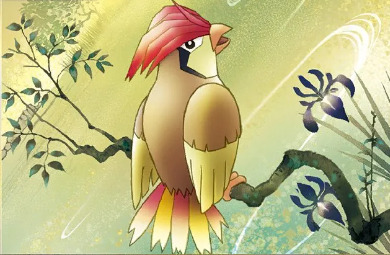
Pidgeotto crests and tails are vibrant yellow and red
HABITAT
Pidgeot are common throughout the Kanto-Johto regions, easily found in trees, grasses, and overhead. Pidgey often remain inland while adult Pidgeot often fly over coastal waters while hunting. Pidgeot are non-migratory and are only rarely seen outside these regions.
Young Pidgey are often found in Kalos near Santalune Forest, though Pidgeotto and Pidgeot are not. The source of these Pidgey is unknown, but there is believed to be a supernatural connection between Santalune Forest and Kanto’s Viridian Forest.

Large crests cause considerable drag but greatly increase their chances of finding trainers or mates.
BEHAVIOR
Pidgeot are birds of prey with preferred diets varying with age.
Young Pidgey search tall grasses for small bugs, which make up the majority of their diet. They frequently hunt Caterpie. Pidgey are timid and otherwise docile, fleeing from perceived threats and flapping their wings to create small sand clouds to cover their escape. Pidgey supplement their diet with nuts, seeds, and berries.
As they grow, Pidgeotto become more aggressive and more territorial as their need for food increases. A Pidgeotto may travel over 100 km away from its nest in search of larger prey, including Magikarp, Poliwag, Goldeen, Spearow, Rattata, Nidoran, Venonat, and Exeggcute. Though Pidgeotto’s talons do not deal significant damage, their strong grip makes it difficult for prey to escape. Pidgeotto may attack other predatory Pokémon or humans to discourage hunting in its territory. Pidgeotto only willingly share territory with siblings, and mated pairs may nest as far as 20km apart. Nests are built as high as possible to avoid predators, but are frequently vulnerable to Ekans.
Fully mature Pidgeot no longer protect territory, instead hunting almost exclusively over water. Pidgeot primarily hunt Magikarp, Krabby, and Horsea, but will continue to attack smaller prey as convenient.
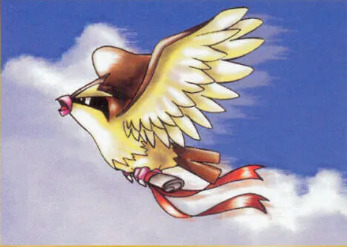
Pidgey carrying a letter
INTERACTION WITH HUMANS
Pidgeot have been regularly tamed by humans as long as 10,000 years ago and are frequent companions. In addition to battling, Pidgeot can be trained to deliver mail, assist in hunting and fishing, and serve as aerial mounts for women and children.
Pidgey are considerably easier to train than Pidgeotto or Pidgeot, and most tame Pidgeot are caught while young and raised by humans. Pidgeot raised by humans tend to become stronger and healthier, and thus more successful in the wild. Due to the tendency for Pidgeot to carry mail long distances over Kanto and Johto, wild and tame populations frequently interact, resulting in Pidgeot as a species only being partially domesticated. This has resulted in wild populations gaining traits considered desirable by humans, such as larger crests, brighter feathers, and reduced wariness that may be disadvantageous in the wild but increase their chances of being captured by a Trainer.
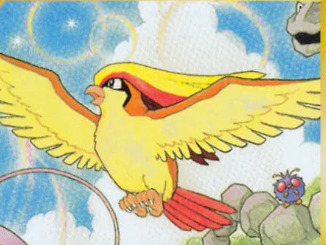
Pidgeot raised among humans are often cheerful and friendly
MUTATIONS
Pidgeot can mega evolve into Mega Pidgeot with the Pidgeotite. In addition to increased size and strength, Mega Pidgeot gains blue feathers at the end of its wings and tail.
NOTABLE PIDGEOT
Trainer Blue of Pallet Town, leader of Alola’s Battle tree, used a Pidgeot in his 1996 Indigo League victory.
Trainer Ethan of New Bark Town used a Pidgeot in his 1999 Indigo League victory.
The Church of Helix venerates a Pidgeot, “Jss,” as a holy figure, believed to be sent by their god to be their savior.

Hamigakimomo’s carving of Jss.
18 notes
·
View notes
Text
WALREIN

Walrein is an Ice- and Water-type Walrus Pokémon. Of all Pokémon, Walrein are the most resistant to cold temperatures and Ice-type attacks, slightly outperforming the closely-related Dewgong.
TAXONOMY
Walrein are Walruses of the Odobenidae family. The name Walrein further derives from the word Reign, implying royalty. The word Walrus may be derived from the words Whale and Horse. Young Walrein are called Spheal, for Sphere, their general shape, and Seal, the clade that includes Walruses. Adolescent Walrein are called Sealeo, a shortened form of Sea Lion. This is taxonomically inaccurate - Sea Lions are a related species distinct from Walruses, and they do not have tusks.

Spheal cannot walk effectively and instead roll when on land or ice
DESCRIPTION
Walrein are quadrupedal marine mammals with considerable bulk and flipper-like feet. Walrein are recognizable by their large tusks and thick, white manes. Walrein are otherwise covered in blue fur, though young have light underbellies and spots to aid in camouflage. Walrein’s thick blubber insulates them, and ice further forms in their fur, providing a sturdy shield and an additional layer of insulation. During cold precipitation, this ice shield reforms rapidly.
Spheal are mostly helpless during their long growth period. Spheal cannot swim well for their first five years, instead floating on the surface of the water and guiding their movements with their flippers. On land, Spheal roll faster than they walk. Spheal’s blubber protects them from impact, but their ice shield can provide a hard impact when they roll into other creatures. Spheal can spit strong streams of water to deter aerial predators and, if attacked, their ice layers may shatter into chilling shards, further discouraging attackers.
As Spheal grow, they learn to intentionally break off ice shards, temporarily inhale them, and send them out at opponents in a freezing spray. Though functionally similar to other ice attacks, these crystals cause significant, noticeable light refraction and give the appearance of a rainbow or aurora ‘beam.’
During adolescence, Sealeo gain the ability to swim properly and begin hunting on their own. They gain increased mobility on land, better able to use their bulk in combat, and increase their mastery over vocalizations and sounds. Sealeo learn complex social behaviors to coordinate other members of its colony as well as to goad and infuriate other Pokémon. This practice allows them to better determine the veracity of taunt and intimidation tactics, even in other species.
Once fully grown, the Walrein’s tusks grow large enough to use as a weapon, enabling devastating bites strong enough to shatter ice. Ice may form over their tusks, both increasing the durability of the tusks and adding sharp shards to their bite attack. Lost or damaged tusks will regrow over time.
Due to their increased size and weight, Walrein can intentionally shatter the shards of ice around their body, creating blizzard-like conditions in a 10-20 meter radius around them. In the water, they can use this weight to create powerful, directed waves to bludgeon and disorient opponents.
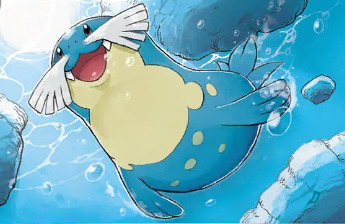
Sealeo have thick whiskers but no mane
HABITAT
Walrein are native to the arctic ocean, spending significant time both in water and on ice floes. Walrein migrate with ice floes, and, during colder months, can be found as far south as Unova and Hoenn.
BEHAVIOR
Walrein are herd animals that form groups of 20-30 members, usually consisting of 1-5 males, 10-15 females, and their children. Walrein herds are led by the strongest male, who is given the duty of battling any potential threats and the opportunity to mate with any females of the herd. Other males may or may not have any opportunity to breed.
Spheal roll around on land and bob in the water with little control, relying on older members of their herd to survive. Spheal vocalize frequently, loudly informing others of threats or prey with barks and claps. A young Spheal typically nurses for two years, after which it transitions to eating aquatic invertebrates such as Shellos and Shellder. These meals must be provided for them, and Spheal will not hunt until they evolve into Sealeo.
Sealeo can hold their breath for over half an hour and will make on average five deep dives a day to hunt for prey and return to the herd with it. When not hunting, Sealeo herd and tend to Spheal, often carrying the Spheal balanced on their noses, and frequently engaging in mock battles. Sealeo have a highly accurate but short range sense of smell and often lift objects onto their noses to learn about them.
Once fully grown, male Walrein leave their old herds, forming herds composed entirely of young adult males. These males regularly battle each other, both as training and to determine who is strongest. As more males join, the strongest will leave to join female-heavy herds, often challenging the current leaders for dominance.

Walrein destroying part of an ice floe to access the water beneath
NOTABLE WALREIN
On January 18, 2014, Hoenn Champion Wallace’s Walrein bowled a perfect game using only its nose, making it the first and only creature to have been verified doing so without the use of hands or psychic abilities.
14 notes
·
View notes
Video
youtube
Who is THE STRONGEST Pokemon Trainer EVER?
I may need to start categorizing external content. I’m not going to be your source of memes, but I’ll be happy to share interesting discussions on the world, especially when it comes to discussing how specific Pokemon interact with the world.
1 note
·
View note
Text
BEEDRILL
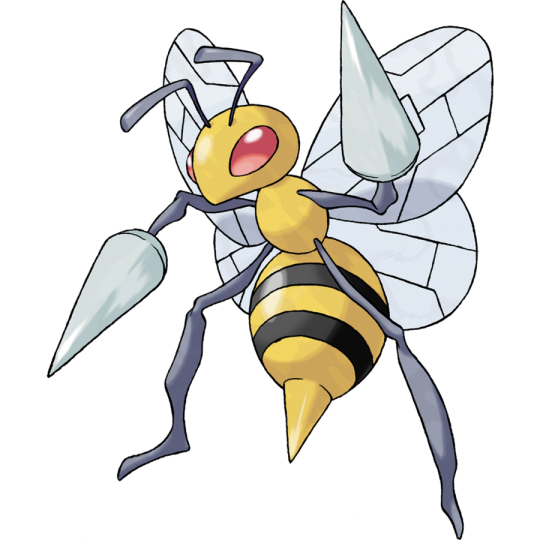
Beedrill is a Bug- and Poison- type wasp Pokémon native to the Kanto-Johto area. They are notable for their large, spear-like claws and virulent poison.
TAXONOMY
Beedrill (Bee + Drill) are Honey Wasps of the genus Brachygastra. The Kantonian language does not have separate words for wasp and bee, so many early translations referred to the creature as a bee before any foreigners were able to properly study them. Though well-known today, the name Beedrill remains common. Repeated attempts to rename Beedrill as the “Kantonian Spear Wasp” have been met with resistance by the general population.
Larval Beedrill, called Beedle in Kanto for Bee Needles, have been correctly translated as Weedle, or Wasp Needles.
Beedrill’s cocoon stage is referred to as Kakuna, which is believed to be the result of the word Cocoon traveling from Galar through multiple regions to Kanto and back.

DESCRIPTION
Beedrill are meter long, yellow wasps with black stripes. Their front legs each end in large, spear-like claw up to 0.4 meters in length. These claws contain a fast-acting venom that causes numbness and slows reaction time while the Beedrill’s stringer contains a slow neurotoxin that often proves fatal.
Beedrill claws grow in conical layers. Outer layers periodically shed, resulting in a sharp point. These outer layers may be flung to harm or poison enemies at short distances.
Unlike most insects, and like many other insect Pokémon, Beedrill only has two sets of legs and stands upright.
Beedrill’s compound eyes are specialized for greater acuity in forward-facing vision, allowing them to focus attention on opponents and better attack vulnerable spots. This accuracy combined with high speeds allows Beedrill to reliably cause significant injury to even the largest creatures.
Beedrill larva, called Weedle, grow to 0.3 meters in length. Primarily yellow-brown with pink prolegs, they have venomous stingers both atop their heads and at the end of their tails. Weedle venom is a painful irritant but rarely causes lasting damage.
Beedrill’s pupa stage, Kakuna, begins when the Weedle is approximately two months old and lasts one to two weeks. Kakuna is nearly incapable of movement but may stick out its stinger to discourage predators. When threatened, they can call for aid from Beedrill with a vibration signal.
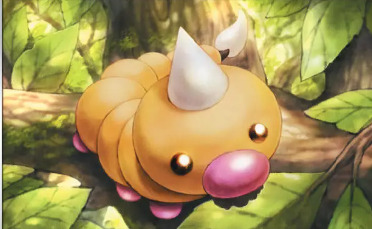
Weedle, a Beedrill larva
HABITAT
Beedrill are common throughout the Kanto-Johto region, most active during late summer and fall. A small Beedrill population lives in Kalos’ Santalune Forest, though in Kalos they are never seen far from that area. This may be due to a supernatural connection between Santalune Forest and Kanto’s Viridian Forest.
BEHAVIOR
Beedrill nest in small colonies of 10-30, often expanding through multiple trees. Beedrill combine wood fibers with saliva to create a paper-like substance to modify these nests, creating combs for their eggs, connecting branches to allow Weedle to pass more easily, and camouflaging their resting spots.
When Weedle hatch, they seek out plant matter to eat. Weedle eat their weight in leaves every day, remaining as close to the nest as possible. They prefer to return to the nest at night but if unable will sleep in bushes. Weedle are timid and will run from predators, expelling silk to slow their attacker. Weedle sting only when cornered.
When the Weedle is ready to pupate, it returns to its nest and spins a cocoon out of silk, becoming a Kakuna. Kakuna may attach to the sides of trees to confuse Zubat’s echolocation or hang directly under branches to avoid being seen by birds.

Kakuna remain mostly motionless until they emerge into Beedrill
Shortly after emerging from their cocoons, male Beedrill leave the colony to search for other colonies to join while the females remain and allow males from other colonies to join them. Newly mated Beedrill will modify and repair the nest to prepare for their eggs, with each couple producing hundreds of eggs.
Beedrill primarily hunt small animals such as Rattata and Ledyba, but often attack and eat larger animals that they consider threats to their territory, including humans. In addition, they gather nectar from flowers to make honey, which they use to supplement their diets during the winter months.
HONEY TRADE
Beedrill honey is a highly sought after delicacy that was outlawed for sale or trade in Kanto and Johto in 1974. Though the substance itself has no ill-effects, the fatality rate of Beedrill farmers was considered unacceptably high, and Beedrill farms resulted in more Beedrill colonies in nearby areas, endangering the general populace. Enforcement of this law primarily prevents actively farming Beedrills, and possession of Beedrill honey is not a crime without intent to distribute.

MUTATIONS
As a direct result of war crimes, Beedrill can Mega Evolve into Mega Beedrill with Beedrillite. Mega Beedrill gains additional spear-like claws on its lower legs and a larger, sharper abdomen. Its venom becomes significantly stronger, both more painful and more deadly. It cannot stand, only hover, but it can fly at over 200 km/h.
28 notes
·
View notes
Text
the big bad eevee speculative biology post
i have been threatening to make this post for so long and now i'm doing it. exorbitant amount of eevee headcanons below the cut (there's pictures i prommy)

eevee is a small mammalian pokemon, and more specifically, a monotreme. (egg-laying mammal) it is omnivorous; feral eevee forage for berries and vegetables, and occasionally hunt small rodents and birds, whereas domestic eevee will eat almost anything they are given. you are unlikely to find eevee in the wild, as as a species, it is domesticated. (all pokemon are friendly and tameable, but eevee is like ACTUALLY domesticated. more on that later) feral populations do exist, but eevee often do not fare well in the wild due to being domesticated. the vast majority of the population are bred in captivity and kept as pets. because of their popularity as pets, they are found all over the world. they are easily recognized by their long ears, fluffy mane, and large tail. they come in varying shades of brown, and may or may not have white or brown markings anywhere on their body. some eevee have longer hair that can be styled by their trainer. male eevee have a jagged patch on their tail while female eevee have a round one.
eevee are friendly and social creatures, and not at all territorial. (though when they evolve, they can become more territorial. as such, proper training is crucial.) they are generally friendly to other eevee, humans, and other pokemon, provided they aren't treated with aggression or hostility. two eevee will often greet each other by sniffing the other to identify them, much like dogs. eevee will often try to greet other pokemon this way too, which sometimes results in confusion for both parties. they are diurnal; active during the day and asleep at night.
eevee are also fairly intelligent creatures. their intelligence could be sort of equated to a human four or five year old. they can understand basic human speech, such as their own name and commands from their trainer, and are good at recognizing human expressions. (just like dogs in real life!) eeveelutions tend to be a bit more clever and shrewd than their unevolved counterparts.
adult eeveelutions or eevee, like most pokemon, can breed and produce a small clutch of eggs. breeding eevee is difficult for inexperienced breeders, as members of the eevee family can only produce eggs about twice a year; a few days in the summer and a few days in the winter. successful breeding will result in a clutch of 1-5 brown and cream colored eggs being laid. at this point the mother becomes highly attentive to her eggs. nesting and incubating them becomes a full-time job for her and the father (if the father is part of the eevee family. behaviors of other pokemon vary)

eevee family mothers and fathers are highly aggressive towards any perceived danger towards their litter; yet another reason why breeders should be experienced before trying to raise eevee.
eevee eggs incubate for about three months, gradually growing in size until they finally hatch. i never really liked how pokemon just came out of their eggs more or less fully grown so i am simply choosing to reject it. <3 when eevee babies hatch, their physiology is noticably different from their fully grown form.

a newborn eevee hatches with cream colored hair, sometimes with faint brown mottling. their ears are short and floppy, and their hearing is poor at this stage. their eyes are completely closed at birth, and the only way they navigate is through smell and some hearing. they have no mane, and their tail is small. they cannot walk and are completely reliant on their mother for protection and milk.
shiny eevee merely skip the browning fur entirely and keep their baby coats. in fact, certain unreputable breeders will sell infant eevee at exorbitant prices, marketing them as "shiny eevee," when in reality it's just a normal baby. such practices are BAD, for more reasons than just swindling people, and any pokemon breeder worth their salt won't separate an eevee from their mother until about the ten week mark.

during this period, their hair starts to turn a light brown, though it's a far cry from their adult coloring. their eyes, which are blue at this stage, open up, but their eyesight is still poor. they can't quite walk, but at this point they're getting stronger, and can crawl around. the fur around their neck starts to grow long; it's the beginning of their mane. though they have developed considerably, they are still fully reliant on their mothers.

by this stage, a baby eevee is now sort of walking, toddling around, learning how to keep its balance and get around. its eyes are completely open and it can see just fine. the eyes are still blue at this point, but they're noticably getting darker as its adult color comes in. their mane is still growing, but now full enough that you could reasonably call it a mane. their ears are standing up more, and their tail will start getting bushier at this point. at around 6 to 8 weeks, they start weaning off of milk and begin eating some soft solid foods. at this point they'll also start making their recognizable cry, rather than just squeaking and mewling. a playful streak emerges as they become less helpless!
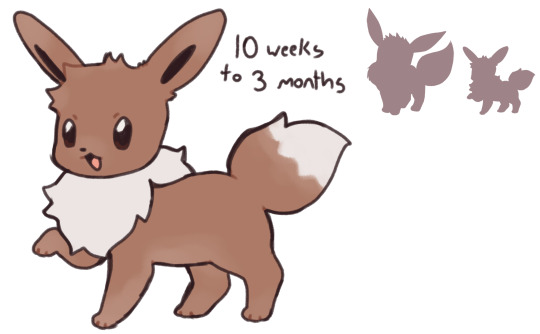
the most development happens in this month. their adult colors and mane are almost completely grown in, and their ears are fully standing now. their tail is still getting there, but it will bush out considerably as they approach the 3 month mark. an eevee of this age is completely weaned off of milk and eating solid food. they can walk and run, and by this point are learning how to be an eevee. they begin to become independent at this point, and the parent(s) become gradually less aggressive and defensive towards others, knowing that the baby is no longer a baby.
by about 1 year old they are just about fully grown, and become receptive to evolution stones and other evolution-inducing situations.
i can't think of a good transition here . i wanna talk about the domestication of ancient eevee
eevee and the eeveelutions are a direct result of domestication and human intervention. they've been domesticated for thousands of years, and have developed massive physical and mental changes as a result. the friendliness and overall docility of the species is one obvious example, but so is their cute appearance and even amount of evolutions.
paleontologists believe the wild ancestor of eevee was first domesticated tens of thousands of years ago, somewhere near ancient kanto. ancestral eevee had only one evolution, dubbed "eon." the type of eon is unknown and hotly debated by paleontologists and historians, but it was probably normal or ground type. it had aspects similar to all known modern-day eeveelutions, and was thought to be quite adaptable, given how many environments they were found in. both ancestral eevee and eon were properly wild animals, and believed to be apex predators of their ecosystems.
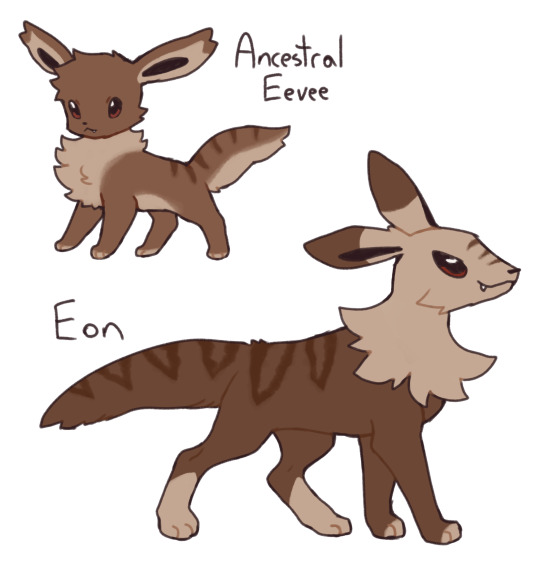
at least until humans came along, anyways. this was ancient civilization, so pokeballs and the concept of pokemon training hadn't really come into existence yet. this made the domestication of eevee all the more interesting; even prior to taming and training pokemon, humans and eevee developed a symbiotic relationship. eevee and eon could do things like hunting for humans and protecting them, and recieve food and protection in return. as years and years passed, eevee and eon became domesticated, and were bred by humans to further suit their needs. as humans spread across the globe, so too did eevee and eon. different groups of people lived in different areas of the world, and so had different needs. this resulted in eon slowly destabilizing and evolving into different varieties, which further diverged and turned into the eeveelutions. it went something like this, each little bubble representing a now-extinct eeveelution that eventually became the modern ones.
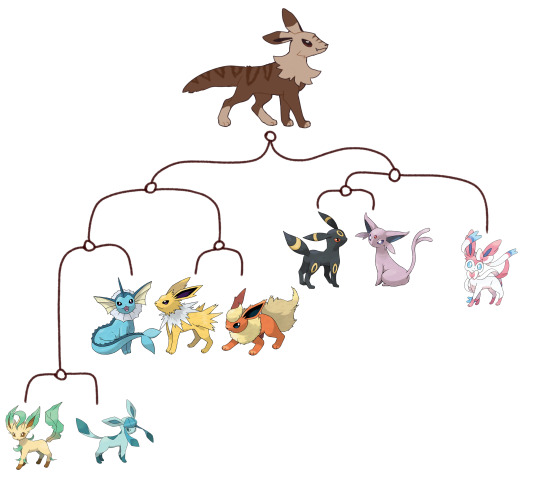
the base evolution, eevee, changed over time but still stayed consistent becauuuuuse idk pokemon science or whatever . you can have a little suspension of disbelief as a treat
anyways if you read all of this: thanks ! it took me hours and i hope it's not too deranged <3
159 notes
·
View notes
Text
TROPIUS

Tropius is a Grass- and Flying- type Sauropod Pokémon, known for its symbiotic relationship with Musa acuminata, the most commonly known banana plant.
TAXONOMY
Tropius is a sauropod dinosaur of the family brachiosauridae, currently the only known sauropod with a wild population. The smallest known sauropod, it is believed to be the result of island dwarfism. Tropius’ common name comes from “Tropical,” both for its habitat and appearance, and “-saurus,” a term commonly used to refer to large reptiles. Tropius was formerly classified as a Symbiotic Pokémon, but Tropius’ plants are lost and regrown frequently, while a true Symbiotic Pokémon consists of the same individuals throughout entire stages.
DESCRIPTION
Tropius are quadrupedal reptiles with short hind legs, long necks, and no tails. They have rough, brown skin and yellow claws. They are 2 meters long and weigh 100 kg. Tropius cover themselves in soil and grow banana plants directly on their bodies. These plants grow over the Tropius, covering its body with a layer similar to leaf stalks to give Tropius its usual woody appearance. In addition, leaves grow over the Tropius’ head and shoulders. Tropius grow large, sturdy leaves from their back that they can move with specialized muscles to use as wings. These leaves are primarily used for temperature control but are strong enough for the Tropius to fly long distances during migration.
The banana plant’s life cycle remains similar on the Tropius as it would in the ground. The banana plant is composed of many individual stems and propagates over time, with the Tropius discarding older stems to allow new growth. Bananas will sprout near the top of the Tropius’ neck when it is approximately two years of age and every six months thereafter.
Tropius prefer temperatures around 26°C and are extremely sensitive to both heat and cold. Overheated Tropius become agitated and reckless while cold causes them to become slow and lethargic.

HABITAT
Tropius live in tropical jungles, though may occasionally be found outside of that range during warmer months. Tropius do not have set migration paths and instead roam constantly in search of food sources and appropriate weather.
BEHAVIOR
Tropius walk or fly long distances in search of fresh fruit to eat and may stay in an area as long as fruit remains available. Tropius supplement this diet by eating leaves, including excess leaves from their own plant, and small insects, many of which attempt to eat their plant. They seek out areas with comfortable temperatures and spend much of their time resting, letting their plants take in sunlight and adjusting their leaves to help control their temperature. When resting a Tropius will dig a shallow hole to sit in soil.
Tropius are social creatures that will travel in herds when food is abundant but may scatter as food is scarce. Females are more likely to gather than males, and Tropius in herds may groom each other by nibbling excess vegetation and insects from hard to reach places. Tropius are rarely violent and react to most threats by digging their feet into the ground and flapping their leaves hard enough to blow smaller creatures away. They may ‘battle’ each other in this way, doing no permanent harm to the other’s body but potentially damaging their plants.
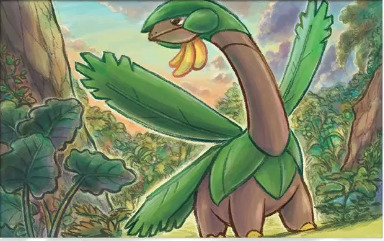
REPRODUCTION
When a male Tropius’ plant bears fruit, he will actively seek a mate. Males entice females with offers of bananas, showing off the health of their fruit as a sign of their own success and fitness. The couple may mate multiple times, though once the male’s bananas are gone they are unlikely to remain together unless food is abundant nearby. The female will build a nest of leaves over the course of the following week, then lay a clutch of four to ten eggs.
Female Tropius will remain close to their nests for the six weeks it takes for the eggs to hatch, during which time she may be vulnerable. If other Tropius are nearby, they will assist in guarding the nest.
Once the eggs hatch, the mother feeds her young her own bananas for the first few weeks of their life and helps them to cultivate their first seeds. Tropius hatchlings are 0.3 meters long, have no visible plant growth until two months of age and do not grow their leaf ‘wings’ until nine months. Once their wings have grown, they may leave their mother.
Female Tropius with no young will feed and care for other young Tropius or creatures of similar size or coloration. Tropius have been seen ‘adopting’ Patrat, Zigzagoon, immature Pinsir, and human children.

HARVESTING BANANAS
Tropius bananas are particularly sweet and are considered a delicacy. Tropius ranching must be done in large greenhouses to ensure proper temperature control and access to sunlight. These ranches primarily raise female Tropius and keep males only for breeding. In areas with wild Tropius, children are often sent out to politely request bananas. Many trainers supplement their income by harvesting and selling their Tropius’ bananas. Though these bananas have a very short shelf life, the advent of digital item storage has significantly increased the ability for them to be sold all around the world.
23 notes
·
View notes
Text
Pokémon Gender and Breeding
Pokémon breed very differently in captivity compared to the wild. There are very few documented cases of Pokémon breeding ‘naturally’ in captivity. Instead, two Pokémon combine their life energy to create an egg. This is a very private affair. When breeding in this way, the egg is always the same species as the mother. There have been some cases of two males creating an egg, which is theorised to be how some all-male species reproduce.
Pokémon in the wild mate in much the same way as humans do. In most cases wild Pokémon mate only with their own species, but when they don’t, some of the clutch will usually be one species, while the rest will be another. All-female species tend to override this and will only produce eggs of their kind.
Different species can breed together so long as they are of the same egg group. Ditto are interesting as they can breed with almost any Pokemon, regardless of egg group or gender. Unfortunately, Ditto cannot produce a Ditto egg. It is currently unknown how they reproduce in any context.
Regional starter Pokémon always skew male. This is because breeders catch and raise a high number of female regional starters to keep up with demand. This has happened with a few other species also, namely Eevee. In many areas, this has led to numbers of wild starters and Eevees dwindling dangerously low. Efforts are being made to improve this. It is also much more likely for Pokémon restored from fossils to be male. Researchers are currently unsure if this is because these fossils are better preserved, if the restoration machines alter the sex, or some other reason.
Interestingly, some Pokémon change sex throughout their lives. Approximately 1/3 of female Azurill will evolve into Male Marill, but not the other way around. In rare cases, a female Espurr who has a preference for defence will become a male Meowstic, and a male Espurr with a preference for attack will become a female Meowstic. This is very uncommon and has only been documented a handful of times.
Gender Unknown Pokémon (sometimes referred to as Genderless Pokémon) reproduce in a variety of different ways. Most can combine their life energy with a Ditto to create an egg.
Despite being in the same evolutionary line, Staryu and Starmie reproduce very differently. Staryu reproduces asexually. Beneath their gem, they have a central disk which is pentametric. It drops an arm and 1/5 of this disk, which then grows the rest of its disk, arms, and orb. Only when it is fully grown can it battle. As it is effectively a replica of the original, a shiny Staryu will always produce shiny offspring. Starmie, on the other hand, produce sexually. Starmie do have a sex, though it is impossible to determine without killing it. They interlock with one or more partners and produce via external fertilization. Sometimes the young will attach themselves to their parents until they are properly developed. A shiny Starmie is no more likely to produce a shiny Staryu than a standard Starmie would.
Magneton breed by coming together in a group, much like Starmie. It is believed they combine their lifeforce (in the same way Pokémon can create eggs) into scrap metal and old appliances, and make Magnemite in their image. Magnemite cannot breed without evolving, as the process is too similar to joining up with others. The Klink line do the same with gears.
Voltorb and Electrode reproduce similarly to Magneton. When a group finds an abandoned pokéball (broken or whole), they put their lifeforce into it. This is believed to be why they no longer resemble old-style pokéballs, though theoretically it is possible. They do not appear to be interested in other types of pokéballs.
Groups of Solrock, and Lunatone come together in rocky fields during midday and midnight respectively. They perform an interesting ceremony, at the end of which the rocks become either Solrock or Lunatone.
Watching a Polteageist reproduce is quite interesting. Several Polteageist will gather around a teacup and simply pour into it. Documented cases have found anywhere from a 1 to 33 Polteageist to participate, though most commonly its between 3-7.
Dhelmise put their life force into seaweed and guide them to shipwrecks to merge with the debris.
Many artificial Pokémon simply create more of their kind. This has been documented with Golurk, Claydol, and Porygon.
It is believed that Cryogonal reproduce when melted into water vapour during the summer. Areas that never get warm enough for this tend to have very few Cryogonal, and often require human interference to maintain their populations.
As Tandemous and Maushold are considered a family group, they have been given ‘gender unknown’ status to encompass the whole group, though individually it is very easy to distinguish males and females. Maushold have never been seen reproducing. One day, their young just appear. When their young are big enough to fend for themselves, they will pair up with another and become a Tandemous. Within a day, the parents have more young.
Despite being ‘gender unknown’, Manaphy and Phione reproduce the same as any other Pokémon. It is believed they do have genders. Whether the egg hatches as a Manaphy or a Phione depends on the water temperature.
Research is being done to discover how other gender unknown Pokémon reproduce in the wild.
48 notes
·
View notes
Text
BUTTERFREE

Butterfree is a Bug- and Flying- type butterfly Pokémon native to the Kanto-Johto area. Butterfree are known to release poison dust and can be very dangerous if frightened.
TAXONOMY
Butterfree are Swallowtail Butterflies in the family Papilionidae. The Kantonian name batafurī comes from a localization of the word Butterfly and the larval name kyatapī similarly comes from the word Caterpillar. The Galarian names Butterfree and Caterpie are combinations of the original words and the Kantonian names.
Butterfree’s chrysalis stage is called Metapod, from the words Meta, meaning both “change” and “between,” and Pod, meaning a long seed, as the Metapod resembles a long seed in which Caterpie changes into Butterfree.
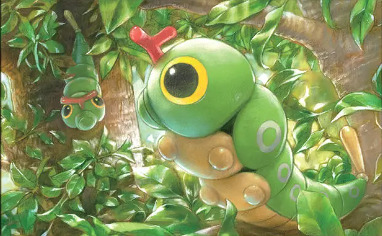
Butterfree caterpillars in Viridian Forest, Kanto
DESCRIPTION
Caterpie are green and yellow, reaching a length of 30 cm. Unlike most Papilonidae caterpillars, Caterpie has no eyespots, instead having two proportionately large compound eyes up to 3 cm in diameter. These eyes serve the same function as eyespots while also giving the Caterpie much better vision than other caterpillars. Colored rings around these eyes further cause them to appear larger. Caterpie’s osmeterium, often mistakenly called antennae, does not retract, instead producing its repellent odor only when threatened.
Caterpie normally move at 0.1 km/hr, but when threatened can move as fast as 8 km/hr for bursts of a few seconds.
Caterpie pupate into Metapod within sixty days of hatching. Metapod are fully green and are usually hidden among leaves. Metapod are approximately twice as long as the initial Caterpie. Metapod are not fully immobile and may hop, but this is an ineffective method of locomotion and is only used to move into hiding.
Metapod emerge into Butterfree after a week to ten days. Butterfree wings are white with black veins and have a wingspan of 1.1 m. Female Butterfree have large black spots on their back winds. A Butterfree’s body is usually purple and blue, though it may be shades of pink. Unlike other butterflies, Butterfree are four-footed, with two large back feet and two small forelegs. These feet are rarely used for standing; the Butterfree grips branches between them and holds tight while resting.
The scales of Butterfree’s wings are water-repellant, enabling Butterfree to fly even when wet. As these scales age, they deteriorate into a toxic powder. This powder deters predators and can be intentionally spread by the Butterfree.
Butterfree have Flying-type elemental affinity and have use their wings to create and control winds. It uses this control in combination with its water-repellant scales to fly during rainstorms. Butterfree can create small bursts of wind to inhibit aerial predators and enable escapes.
Though not Psychic-type Pokémon and not otherwise showing signs of higher intelligence, Butterfree can produce psionic blasts. These blasts are usually more disorienting than harmful, but they can cause unconsciousness.
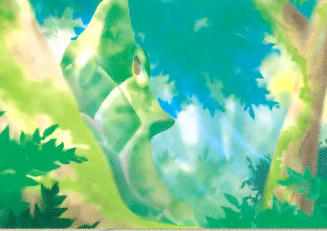
Metapod are well camouflaged in forest environments
HABITAT
Lone Butterfree may be found nearly anywhere in temperate and tropical climates, but thriving populations are primarily limited to the Kanto-Johto region, centered in the Viridian Forest, and the Alola region, centered in the Akala Jungle. Wild caterpie rarely survive long enough to mature outside of these dense, wooded areas along the Pacific coast.
BEHAVIOR
Caterpie eat leaves and do little else unless disturbed. Caterpie primarily rely on mimicry to disguise themselves as snakes, but if threatened will release a foul odor. This odor repels Spinarak but is less successful against birds such as Pidgey, Spearow, and Pikipek. If pursued, the Caterpie may expel silk at its attacker to slow it before fleeing. When the Caterpie is ready to pupate, it will find a spot where it can hide in foliage.
Metapod do not eat and do not move unless their hiding spot becomes unsustainable. If this happens, the Metapod will seek out a new location by hopping along the ground.
Once emerged, a Butterfree builds a small nest, often in the same spot. It then begins searching for nectar and honey, going up to ten kilometers from its nest each day. In addition to eating its fill, the Butterfree will coat its hind legs in food to bring back to its nest.
Butterfree frequently compete for food with other Bug-types in an area. In Kanto and Johto, Butterfree battle with Beedrill both over nectar and over the Beedrill’s honey. In Alola, Butterfree have territorial disputes with Ribombee. These battles are larger threats to Butterfee than any natural predators.

Butterfree collecting nectar
REPRODUCTION
During early summer, Butterfree leave their nests to seek out mates. Males perform elaborate aerial courtship dances and may battle other nearby males. Once the female chooses the male, they remain mates for the duration of their lives. The female may lay her eggs in either Butterfree’s nest, or they may seek out a new nest together. These eggs hatch after approximately four weeks.
After mating, Butterfree do not distinguish between their own young and other Caterpie. If any Butterfree sees any Caterpie in danger, it will assist, even if this means directly attacking predators.

Butterfree may congregate in large groups during mating season
CATERPIE FARMING
Harmless and with rapid growth, Caterpie are farmed for a number of common uses. Caterpie silk production is higher than that of any non-Pokémon animal, and Caterpie silk farms are an important industry in Kanto and the surrounding regions. Caterpie’s osmeterial secretions, the source of its foul odor, are harvested as a component in Repels. When these Caterpie are ready to pupate, they may be used as animal feed.
MUTATIONS
When using the power of a Dynamax Power Spot, Butterfree may show a Gigantamax transformation. This minor transformation lengthens their wings and tints them green. Gigantamax Butterfree’s toxins become far more potent and are a significant hazard to humans.
12 notes
·
View notes
Text
SABLEYE

Sableye is a Dark- and Ghost- Type spirit Pokémon that appears as crystals suspended in a dark, humanoid shape. Sableye’s true origin is unclear but leading theories claim that they are the ghosts of humans whose souls were corrupted by greed.
TAXONOMY
Sableye are fully spiritual Pokémon of debated classification. Many researchers believe Sableye to be human spirits, whose souls have been corrupted in a search for wealth and are thus unable to pass on. Competing theories suggest that Sableye are the souls of Rock-type Pokémon attempting to restore their bodies or that they are elementals made of spirit energy rather than the soul of the dead.
Originally called “The Eyes in Sable,” Sableye’s modern name is derived from sable, the heraldic tincture for black, and eye.
DESCRIPTION
Sableye are bipeds with large heads and what appear to be large ears or fins. Sableye bodies are a uniform dark purple in color with small eyes. Each hand and foot ends in three digits, each of which usually in claws made of crystal rather than keratin. Sableye grow large, cut crystals over their eyes as lenses that enhance light and magnify vision. These eyes often reflect light and appear to glow. Sableye have wide mouths with crystal teeth. Each Sableye’s body contains visible crystals and shards, creating unique patterns that change with time. Sableye have a red gem in the center of their chest, called their heart gem, that remains constant their whole lives. This heart gem has very high durability and has not been known to show signs of damage. Other than the Sableye’s heart gem, any crystal component of the Sableye’s body may be lost or replaced many times throughout its life. The Sableye’s ‘true’ body consists only of the heart gem and spirit energy. Sableye can intentionally draw their crystals inside themselves for short periods of time. This allows the Sableye to become uniformly dark and difficult to detect. Much of Sableye’s body can pass through solid objects, but its crystals cannot. Sableye can move through any opening wide enough for its largest individual crystal.
Sableye average 0.5m in height. Their weight is highly variable due to their collected crystals. Sableye average 11 kg, but the weight of their heart gem plus spiritual body is approximately 0.04 kg.
Sableye do not display any physical sexual characteristics and cannot be psychically sexed but experiments with Salazzle pheromones suggest a standard gender division.

Sableye can easily climb cave walls
HABITAT
Sableye may be found anywhere that crystals naturally form. Sableye live in caverns and deep underground, only rarely traveling to the surface during dark nights. Sableye have been found on isolated islands.
REPRODUCTION
It is unclear whether Sableye coupling has any bearing on reproduction. Natural Sableye reproduction has never been observed and most researchers do not believe it possible. Sableye’s presence in areas rich in valuables, higher frequency near human habitation, and tendencies to hoard gems have led many researchers to believe they are formed from the souls of humans who have died seeking wealth. Those who believe Sableye to be an Elemental rather than a true ghost believe Sableye spawn from crystals that naturally collect Dark energy from nearby creatures.

When a Sableye’s mouth is closed, it seems to disappear entirely
BEHAVIOR
Sableye spend most of their time collecting crystals. They remain in darkness while burrowing with their claws, seeking crystals. Some crystals are chewed into shards and used to enhance or replace the Sableye’s claws, teeth, or lenses, while others are embedded into their bodies as ornamentation. As their bodies get heavy with crystals, they discard older, more common crystals in favor of rarer ones.
Sableye may hunt crystalline Pokémon given the chance and are well known for preying on Carbink. Sableye hide in darkness to stalk their prey until they get an opportunity to corner it, at which point they strike. They usually strike with their claws but can make attacks directly to a target’s soul by striking with their bodies. Sableye do not prey on animals but may attack humans to steal jewelry.
Sableye act aggressively toward other creatures that approach crystals they can see, including most other Sableye. Though usually solitary, a Sableye may choose to court another. Sableye courtship may take years. The first few months of this courtship involve regularly making its presence known to other Sableye without appearing threatening. After the potential partner is acclimated to its presence, the Sableye may dance, sing, and give gifts of crystals over multiple sessions. If the Sableye is accepted, the two will remain partners indefinitely.

Sableye aggressively defend their crystal claims
HARVESTING LENSES
The crystal lenses Sableye create are widely sought after for their vision-enhancing uses. While all attempts to farm Sableye have failed, skilled trainers can catch wild Sableye, remove these lenses, and release the Sableye with minimal harm. While this upsets the Sableye, it shows no no signs of lasting damage. These lenses are most commonly fashioned into monocles called “Wide Lenses.”
Attempts to collect Sableye’s internal crystals have historically resulted in increased hostility from the Sableye and are not considered sustainable.

Sableye crystal fashioned into a Wide Lens
MUTATIONS
Sableye can mega evolve into Mega Sableye with the Sablenite. Mega Evolution does not significantly alter Sableye’s body, but causes its heart gem to detach and grow as large as the rest of the Sableye. Though not significantly more powerful, Mega Sableye can use its heart gem as a seemingly indestructible shield.
NOTABLE SABLEYE
Chief Golgo of Cerulean City captured a Sableye capable of spitting cephalopod-like ink.
28 notes
·
View notes
Text
GLOSSARY
Elemental: An Elemental Pokémon is a Pokémon without a functioning biology. How such a Pokémon is animated varies from species to species.
Spirit: A creature made of spiritual energy rather than matter. Most Spirits are believed to be formed from the souls of the dead, though there are exceptions, such as Rotom. (Editor’s note: Hello Rotom!)
Symbiotic: A Symbiotic Pokémon is a single Pokémon consisting of two or more distinct creatures, possibly of multiple species.
PokéEgg Reproduction: A secondary method of reproduction available to most Pokémon, in which an egg mysteriously appears between two Pokémon who may or may not be normally capable of reproducing, even if neither are normally Egg-laying creatures. The Pokémon hatched from this egg may be far more mature than it should be for its age and may hatch with non-biological items.
Pokémon: Short for “Pocket Monster,” Pokémon are creatures with supernatural abilities. These creatures may be similar to other creatures or entirely unique entities. All Pokémon can supernaturally shrink to approximately 1/100th their original size or resume their normal size as desired. Pokémon are currently classified within eighteen types.
Type: The eighteen categories that determine how an individual being reacts to different energy types. Each Pokémon is of one or two types but may be able to use abilities of other types as well. Types with an asterisk have also been observed in humans.
Normal*: Normal types are fully material beings that primarily attack with claws and ramming attacks. Normal types cannot be harmed by immaterial, Ghost-type attacks. Most Pokémon are capable of using Normal attacks. Normal Types include most Non-Pokémon vertebrates.
Bug: Bug types are invertebrates with exoskeletons. Bug types tend to be small, weak, and plentiful. Bug type includes Non-Pokémon arthropods.
Dark*: Dark types, sometimes known as Evil types, are attuned to mental energies of violent or hostile intent. Dark types cannot be harmed by Psychic-type attacks. Dark type attacks often involve deceptive tactics.
Dragon: Dragon types are attuned to chaotic, destructive magic with a distinctive blue or purple aura. Dragon types tend to be large, powerful, and rare.
Electric: Electric types are attuned to electricity and can either generate it or store significant amounts.
Fairy: Fairy types are attuned to magic that often appears as pink mist. Fairy magic prevents the use of Dragon magic. Fairy types are usually physically weak but resistant to energy attacks, and are particularly vulnerable to Poison and Steel.
Fire: Fire types are attuned to fire. They can create fire internally and are adapted for high temperatures.
Fighting*: Fighting types are attuned to their bodies in the way other types are attuned to elements. Fighting types attack with punches, kicks, and throws. Fighting types tend to be physically powerful.
Flying: Flying types are attuned to the air. Flying types are lighter than other types when airborne and gain increased maneuverability and speed. Some Flying types can create strong winds. Not all Pokémon that can fly are Flying types.
Ghost*: Ghost types are immaterial and attuned to spirit energy. They cannot be harmed by Normal or Fighting type attacks and cannot be restrained by any known means. Many Ghost types arise from the spirits of dead humans or Pokémon.
Grass: Grass types are in whole or in part plants or fungi. Grass types are not susceptible to harm from the pollens or spores of other Grass types. Non-Pokémon Plants and Fungi are Grass types.
Ground: Ground types are attuned to sand and soil. Ground types are strong conductors of electricity and are not harmed when a current passes through them. Ground type attacks are low and use the ground as weapon or support and thus are ineffective against Flying types.
Ice: Ice types are attuned to cold. Ice types tend to be hardy and become even more so as temperatures decrease. Ice types can often summon or create cold effects.
Poison: Poison types are attuned to toxins. Poison types are immune to nearly all poisons and venoms. Poison type attacks use venom, poison, acid, or smog to attack.
Psychic*: Psychic types are attuned to calm mental energies. Psychic types use telepathy and telekinesis to attack.
Rock: Rock types are slow, solid and sturdy, often with stoney exteriors. Rock types may possess both an endoskeleton and an exoskeleton. Rock type attacks often involve using terrain to indirectly attack the opponent.
Steel: Steel types have significant amounts of metal in their physical composition. Steel types are slow, solid, and sturdy, often with metal exteriors. Steel types are resistant to most attacks. Steel type attacks usually involve ramming the opponent.
Water: Water types are attuned to water. Water types are more maneuverable in the water. Water type attacks often involve storing and expelling pressurized water. Water is the most common type among Pokémon.
6 notes
·
View notes
Text
Index
Preface
Glossary
Pokémon (in Alphabetical order)
Beedrill
Blastoise
Bulbasaur
Butterfree
Caterpie
Charizard
Charmander
Charmeleon
Ivysaur
Kakuna
Metapod
Pidgeot
Pidgeotto
Pidgey
Sableye
Sealeo
Spheal
Squirtle
Tropius
Venusaur
Walrein
Wartortle
Weedle
2 notes
·
View notes
Text
WARTORTLE

Wartortle is a Water-type turtle Pokemon noteworthy for its furry tail and long lifespan. Wartortle are native to the Pacific Ocean and surrounding coastal areas. Wartortle have the longest confirmed lifespan of any creature.
TAXONOMY
Wartortle are Terrapins or Pond Turtles of the Emydidae family, though their furred fins and tail are unique traits among Terrapins. The name Wartortle is a combination of Warrior and Turtle, as older Wartortle are often covered in scars. Young Wartortle are called Squirtle, though sources differ as to whether this originally meant Squirt Turtle for its tendency to spit water or Squirrel Turtle for its large tail.

Wartortle and Horsea expelling streams of water
DESCRIPTION
A Wartortle is a bipedal turtle with blue scales, a brown carapace, and a yellow plastron (belly-plate). On their heads they have fins covered in white fur, which resemble ears, and long, furry tails. This fur traps oxygen bubbles, providing additional buoyancy and helping the Wartortle maneuver in the water. The Wartortle can use these trapped bubbles as additional air to allow for extended dives. Algae may grow on a Wartortle’s shell and fur, giving it a green tint. Squirtle hatch with soft shells and without fins or fur, both of which grow in with age. Wartortle store water within their shells, which can be pressurized by specialized internal muscles, and can increase or decrease this pressure to adjust their buoyancy, as well as expel this water from their mouths in a targeted stream, either when threatened or to stun prey.
Wartortle average 1 meter in height with a weight of 22.5 kg.
Wartortle are commonly claimed to live 10,000 years, and no evidence exists of a Wartortle suffering from age-related disease. The longest continually tracked Wartortle was discovered in 1535, making it the oldest confirmed living creature, though there are many unconfirmed claims of older Wartortle. Wartortle heal injuries more efficiently than most other species, though the healing process often leaves scars.

Young Wartortle, called a Squirtle
HABITAT
Wartortle are rarely seen and have large migratory ranges, primarily in the Pacific Ocean and surrounding regions. Wartortle can traverse land and occasionally make homes in freshwater lakes but no individual area has a significant Wartortle population.
BEHAVIOR
Wartortle are omnivores with a primarily vegetarian diet, however, they also consume small animals. Wartortle may hide under the water’s surface to attack creatures that come too close. When threatened, Wartortle withdraw into their shells and expel pressurized water at the attacker. If the shell is cracked, the Wartortle becomes extremely aggressive, biting and striking with its tail. Wartortle do not nest and instead sleep inside their shells. Their controlled buoyancy allows them to sleep on the surface of the ocean.

Trained Wartortle posing
REPRODUCTION
Wartortle only reproduce once every 3-5 years. They lay a clutch of 4-10 eggs, then bury their eggs on land near a body of water. The parents do not remain nearby. When the eggs hatch, the Squirtle must fend entirely for themselves. Most Squirtle do not survive to maturity.
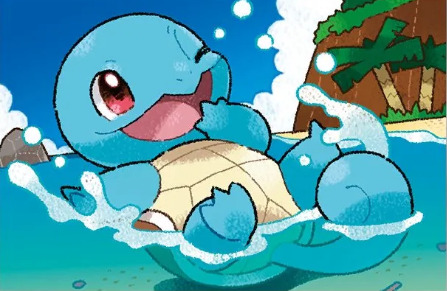
Newly hatched Squirtle often have difficulty controlling themselves in water.
MUTATIONS
When raised by humans, the Wartortle may evolve into the Blastoise (derived from Blast and Tortoise), becoming significantly larger and heavier while losing its fur. Blastoise grow two bone ‘cannons’ from their shell they use to spray water at potentially thousands of PSI. Blastoise are far more powerful and durable than Wartortle but require significantly more food and are neither quick enough nor maneuverable enough to be effective hunters. Blastoise are not normally found in the wild and attempts to reintroduce Blastoise to the wild have been unsuccessful.
Blastoise can further evolve into Mega Blastoise with the Blastoisinite, becoming sturdier, heavier, and growing a larger, more powerful cannon.
In Galar’s Power Spots, some Blastoise have been shown to have a unique Gigantamax transformation where it gains an additional twenty eight cannons. Rather than create rain as other Water-Type Pokemon do at Power Spots, Gigantamax Blastoise unleashes a barrage of pressurized water blasts.

Blastoise can fire water with enough pressure to puncture steel
NOTABLE WARTORTLE
Trainer Red of Pallet Town, leader of Alola’s Battle tree, used a Blastoise in his 1996 Indigo League victory.
“Camila” was captured by Paldean explorers in 1535 and holds the official record for oldest living Pokemon.
“Wakame” is an algae-covered Wartortle with repeated sightings off the coast of the greater Kanto region. The first recorded Wakame sightings occurred between the years 400 and 500, but cannot be proven to be the same Wartortle.
18 notes
·
View notes
Text
Charizard

Charizard is a Fire-type lizard Pokémon, notable for the live flame at the end of its tail. When fully matured, it becomes a Fire- and Flying-type Pokémon. They are native to Galar and are known for their particular aggression.
TAXONOMY
Charizard are Dragon Lizards in the family Agamidae, though they have historically been referred to as Salamanders or Dragons. The name Charizard comes from Char (to burn) and Lizard. Young Charizard are called Charmander from Char and Salamander. The Salamander misnomer is common and is shared with another Pokémon in the same family, Salandit. Adolescents are called Charmeleon from Char and Chameleon. Though incorrectly classified by modern taxonomic standards, Chameleons are close relatives of Dragon Lizards.
DESCRIPTION
Charizard are bipedal lizards with large wings. They average 1.7 meters in height or 2.1 meters in length (nose to tail) with a wing span of 2.5 meters and a weight of 90 kg. They have long tails ending with a live flame fueled by oils the Charizard produces naturally. The flame ignites upon a newly-hatched Charizard taking its first breath and remains lit as long as the Charizard continues to breathe. Charizard’s arms and legs each have three digits with sharp claws.

Newly hatched Charmander may imprint on humans
Charmander hatch without wings, with dull orange scales and a pale underbelly. As they mature to their adolescent stage, Charmeleon, their scales darken and they begin to grow horns. These horns begin close enough together to share a layer of scales, giving the appearance of a single horn. When the Charizard reaches full maturity, it goes through a complete molt, replacing its dark scales with vibrant orange scales and revealing large wings with blue-green undersides. During this molt, its horns separate, appearing as two distinct horns. X-Rays of Charmander and Charmeleon reveal the wing bones exist from birth and continue to grow subcutaneously until this molt.
Charizard naturally produce and spit a flammable oil which ignites upon contact with oxygen. As the Charizard grows it gains a greater ability to control and direct this spit. In order to conserve this oil, Charizard prefer to attack with their claws. A Charizard can snap its wings forward at speeds sufficient to cause a gust of wind of over 200 kmh, but cannot raise its wings quickly enough to sustain it. Despite not being a true Dragon, a Charizard can channel Draconic energy into its claws or fire breath, identified by a blue aura.
Charizard’s natural flames make temperature regulation difficult. If a Charizard overheats, its oils may ignite internally, forcing it to release flames more powerful and less controllable than usual. In these circumstances, Charizard become dangers to themselves and others. Similar results may occur when a Charizard is injured.

Charmeleon in Galar’s mountains
HABITAT
Charizard are native to the Galar region where they reside primarily in mountain caves. Charizard use their flames over long periods to melt rock to their liking, creating well-defended dens. Due to Charizard’s range and popularity among trainers, wild Charizard have occasionally been spotted in other regions, and there is believed to be a breeding population in Kanto. The long term effects of this are currently unclear. Charizard are strongly attracted to Dynamax Power Spots and rarely leave Galar for nearby regions.
BEHAVIOR
Charmander are timid creatures that rarely venture far from their parents’ den. They hunt at dusk and dawn by raising their tails to attract bugs, birds, and other small creatures to the flame, though this diet is supplemented by scraps of their parents’ meals.
Once a Charmander has grown into a Charmeleon, it leaves to seek out or create its own den. Charizard are territorial carnivores that will attack creatures much larger than themselves and continue to seek opponents even when fully fed. Charizard carry food back to their dens to eat in safety and to share with their mates and young. Charizard prefer Dynamax Power Spots as their den locations and will relocate to one whenever possible, often challenging the current resident despite their access to Dynamax power. They will attack anything they perceive as a potential threat, including other Charizard of the same sex. Fully mature Charizard can increase the range of their territory as far as 500 km2.
Charizard are known to attack human settlements built on Dynamax Power Spots, using their flames to raze entire villages. In modern times, all such settlements have defense plans in place.
Kanto’s Charizard are believed to reside in Mt. Moon. It is theorized that this is due to Moon Stones and Dynamax Power Spots both resulting from radiation from meteorites.

Trained Charizard using a Fire attack
REPRODUCTION
As male and female Charizard do not compete with each other for territory, any pair with overlapping territory may mate without forming long-term bonds. A male and female Charizard may share a den, resulting in functional monogamy, though this usually only occurs if the den is a Dynamax Power Spot.
Charizard lay clutches of 1-4 eggs at a time. Charizard embryo sex is temperature-dependently determined with colder temperatures producing male Charmander and warmer temperatures producing female Charmander. The most important factors in the temperature of a Charizard egg are the presence or absence of a second parent and whether the den has a natural heat source. Due to these factors, most Charmander are born male, while those incubated on Dynamax Power Spots are usually female.
MUTATIONS
Black-scaled Charizard with white bellies have been photographed. The cause for this mutation is unclear. Theories include unusual Mega Stone exposure, hybridization with Salandit, and Melanism.

Black Charizard above Galar
Charizard can Mega Evolve into Mega Charizard Y with the Charizardite Y. This greatly increases the Charizard’s oil production, resulting in much stronger flames and drastically increasing the temperature around it. Mega Charizard Y are faster and far more maneuverable than normal.
Charizard can Mega Evolve into Mega Charizard X with the Charizardite X. This turns Charizard’s scales black and infuses it with Draconic Energy, making its flames blue. This transformation greatly increases Charizard’s muscle mass, making it more powerful but significantly inhibiting its ability to fly.
Charizard is the only known Pokémon with two different Mega Evolutions.
When using the power of a Dynamax Power Spot, many Charizard show a Gigantamax transformation. While the heat of most Dynamax Fire types radiates and greatly increases local temperatures, Gigantamax Charizards instead release this heat in controlled fires to attack their opponents.

While using a Dynamax Power Spot, a Charizard can temporarily grow to over 25 meters in height.
NOTABLE CHARIZARD
Trainer Red of Pallet Town, leader of Alola’s Battle tree, used a Charizard in his 1996 Indigo League victory.
Trainer Leon of Postwick, former Champion of Galar, used a Charizard as his primary partner in his world-record undefeated streak from 2007 to 2019.

Trainer Leon of Postwick and his Charizard
19 notes
·
View notes
Text
Venusaur

Venusaur is a Grass- and Poison-type symbiotic Pokémon composed of the unclassified animal Sapusaur and the Venus Flower. Sapusaur and Venus Flower spend their entire lifecycle together; neither species can survive independently. Sapusaur’s classification is under significant debate. The Venus Flower is a member of the genus Rafflesia, unique in that it serves as a symbiont rather than a parasite. With no access to a full wild population of Venusaur, much about this Pokémon remains unknown.
TAXONOMY
Initially called Fushigidane or “Mysterious Seed” by Professor Samuel Oak, the Venusaur’s actual nature was under debate almost immediately. The flower received the Rafflesia Venus designation, both for its comparative beauty and genus membership, and for its "loving" symbiotic, rather than parasitic, nature. Discussion on whether the animal attached was frog, lizard, dinosaur, or other is still ongoing, with various languages using different terms. The name Sapusaur is derived from the energy it receives from the Venus Flower’s sap and the -saur suffix, which is utilized in many dinosaur-like creatures. In other regions, the Sapusaur is called “Miracle Frog” or “Strange Creature.”
DESCRIPTION
Sapusaur are blue-green quadrupeds with round frog-like bodies and sauropodian legs, although the legs additionally possess clawed toes. When fully grown, they stand approximately one meter tall and two meters long, weighing roughly 100 kg. Like frogs, they have large, wide mouths and small fangs. Sapusaur young are a vibrant green with dark spots to aid in camouflage, and as they grow older their skin darkens until these spots are no longer visible, growing wart-like bumps in the process. Sapusaur skin is dry and rough, similar to a toad. In contrast to frogs, Sapusaur have external ears and do not have a tadpole stage.

A young Venusaur, called a Bulbasaur, releasing powders
During the Sapusaur’s embryonic state, a Venus Flower bulb begins sprouting from the Sapusaur’s back, giving this earliest stage the name Bulbasaur. Even at this young age, the bulb contains long, prehensile vines, fully under the control of the Sapusaur. As the Sapusaur matures into adolescence, the bulb opens, revealing a budding flower. The bulb retains its outer leaves, which are spread over the Sapusaur’s back. This adolescent phase is referred to as Ivysaur. Late in adolescence, the budding flower begins to release a sweet scent, used to attract prey. When the Sapusaur is fully grown, the flower grows and blooms as well, a small trunk raising it to keep the petals from falling directly onto the Sapusaur.
Both components of a Venusaur share nutrients, allowing this Pokemon to subsist on both vegetative and animal diets. A Venusaur can survive on sunlight and water, as a plant, or by consuming meat and fruit, although the Venusaur’s optimal diet is comprised of both. In direct, strong sunlight, the Venus Flower’s production of sugars can give the Sapusaur a temporary boost of speed, and in situations of extreme stress the Flower can draw energy from the Sapusaur to fortify itself.
Venusaur’s primary method of hunting uses the Venus Flower’s vines to whip and constrict its targets. The Venusaur then swallows defeated prey whole. It can also embed its vines into prey to enable the flower to feed on them directly. This method is used primarily to consume larger prey or to weaken prey while still fighting it. The Venusaur can also throw small, sharp leaves at its foes. As the flower grows and blooms, its combat options expand. Aggressively shaking the flower unleashes spores that can cause severe allergic reactions to most creatures, though the Sapusaur quickly grows inured to these effects. Once fully bloomed, the Venusaur can ‘dance’ to throw out a cloud of damaging petals. When sufficient sunlight is available, a fully grown Venusaur can rapidly metabolize to heal quickly or unleash the solar energy into a powerful beam attack.
Cross-pollination with Gloom, another Pokémon of the Rafflesia genus, can result in a Venus Flower with far deadlier toxins than usual, though there is no verifiable evidence of this occurring in nature.
As with some other Rafflesia, the Venus Flower’s sex ratio is highly skewed, with seven males to every one female. This becomes reflected in the Venusaur, as plant and animal invariably share a sex, likely due to the Rafflesia’s unique tendency for genetic material transfer.

An adolescent Venusaur, called an Ivysaur, throwing sharp leaves
HABITAT
Little to nothing is known about Venusaur’s habitat or the size of its population in the wild. Bulbasaur have been encountered in Kanto’s Viridian Forest, but not in numbers large enough to suggest a natural population, and no adult Venusaur have been seen in the wild. Most currently known Venusaur derive from a population bred in captivity at Professor Oak’s laboratory in Pallet Town, Kanto.
BEHAVIOR
Venusaur are relatively passive creatures, preferring to move only to stay in sunlight. They hold themselves low to the ground and use their vines to grab anything that they believe they can fit in their mouths. In the Viridian Forest, this primarily consists of Caterpie and Weedle, both of which are attracted to the young Venusaur’s leafy bulb. Venusaur raised from Bulbasaur quickly learn to accept humans and pose little threat, though Antidotes should be kept handy in the event of accidental poison powder. There have been no verified encounters with fully grown Venusaur not raised around humans.
Due to the lack of encounters with wild Venusaur, much of their natural behavior is unknown and their general docile nature may be a result of human interference.
REPRODUCTION
Female Venusaur in captivity lay eggs only rarely and only when left in the company of a suitable mate. Immediately upon laying an egg, they implant a single, large seed into it, then wrap the egg in many layers of leaves. Venusaur reproduction in the wild has not been observed, and Pokémon Eggs laid in captivity are often not indicative of a Pokémon’s natural reproduction cycle.
Nothing is known about Venusaur’s natural mating habits. All observed breeding pairs have done so in captivity. Captive Venusaur do not form long-term pair bonds.
MUTATIONS
Venusaur can Mega Evolve into Mega Venusaur with the Venusaurite. This greatly increases the Venusaur’s power, and the increased bulk protects it from extreme temperatures, though pushed to its limits in this way it can no longer exchange energy between its component species for speed or power.
In Galar’s Power Spots, some Venusaur have been shown to have a unique Gigantamax transformation. Gigantamax Venusaur, rather than spreading grassy terrain as other Grass-type Pokémon do when exposed to Power Spots, fills the ground with vines that continually attack its foes.
NOTABLE VENUSAUR
Trainer Red of Pallet Town, leader of Alola’s Battle tree, used a Venusaur in his 1996 Indigo League victory.
29 notes
·
View notes
Text
Preface
While various Pokédexes and encyclopedia have come into being, I find that most seem focused not on the natural biology of these creatures, but of their capabilities in battle and use by trainers. Indeed, battling dominates the field of Pokémon study. The purpose of this Encyclopedia, then, is to discuss Pokémon in their natural state, how they live and interact in the wild, and how they interact with human society outside of their capabilities in battle.
The information contained within comes from a variety of sources. While it leans heavily on that of notable researches such as Laventon, Oak, Birch, Elm, Rowan, Sycamore, Kukui, Magnolia, etc., much of the information found within comes from my own observations in the field over the past three decades, as well as those of my aides and trainers who have shared their data with me.
While this Encyclopedia will touch on all relevant information, it will not delve deeply into information only relative to how the Pokémon functions under the control of a Trainer. For example, while Vileplume are well known, Gloom do not naturally seek out Leaf Stones in the wild, and so there is no notable ecology for Vileplume outside of Galar.
Further, this encyclopedia will focus on Pokémon as species, not as individual evolutionary stages. While it is useful to note the distinction between Oddish and Gloom in battle, Oddish and Gloom are ultimately the same creature, and all Gloom began their lives as Oddish.
Finally, I must address a common misconception before we begin. While most Pokémon are capable of producing PokéEggs to give to their trainers, it is important to note that this is not the primary reproduction method of most species. See Professor Elm’s research for more information.
1 note
·
View note